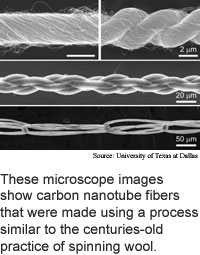
Tight twist toughens nanotube
fiber
Researchers from the University of Texas
at Dallas and the Commonwealth Scientific and Industrial Research Organization
(CSIRO) in Australia have strengthened carbon nanotube yarn by introducing
a tight twist as the nanotubes are spun. The method taps the secret of
spinning discovered in the Late Stone Age: a tight twist produces a tough
fiber.
Nanotubes are rolled-up sheets of carbon atoms that can be narrower
than a nanometer and stronger than steel by weight. A nanometer is one
millionth of a millimeter. Multiwall nanotubes contain several layers
of successively larger tubes.
The researchers showed that it was possible to spin forests of
multiwall nanotubes into multi-ply yarn that is as strong as 460 megapascals,
which is close to the strength of fibers used in bulletproof vests. The
technique produces yarn that can be knotted and that preserves the nanotubes'
useful electrical and optical properties, according to the researchers.
The yarn could be used in flexible clothing that protects the
wearer from ballistics, static discharge, and radio and microwave radiation.
It could also be used in materials to dampen mechanical vibrations, provide
structural reinforcement and efficiently dissipate heat. The yarn could
also be used as filaments for incandescent light, flexible wires, electronic
elements that could be woven into materials like textiles, artificial
muscle, and supercapacitors that store large amounts of electricity.
The researchers grew dense forests of vertical nanotubes ranging
from 8 to 15 nanometers in diameter and 300,000 nanometers, or 300 microns
tall. A nanometer is one millionth of a millimeter. Pulling at the edge
of the forest draws the nanotubes into filaments. Twisting the filaments
produces fibers. A 200-micron wide forest edge yields a two-micron diameter
fiber, and a 1-square-centimeter forest a 50-meter-long fiber, according
to the researchers.
The work appeared in the November 19, 2004 issue of Science.
For pure nanotubes add water
Solar cell doubles as battery
Conversational engagement tracked
Pure silicon laser debuts
Briefs:
Tight twist toughens nanotube fiber
Multicamera surveillance automated
Chemical keeps hydrogen on ice
Smart dust gets magnetic
Short nanotubes carry big currents
Demo advances quantum networking

Research Watch blog
View from the High Ground Q&A
How It Works
RSS Feeds:
News
Ad links:
Buy an ad link
Ad links: Clear History
Buy an ad link
|
TRN
Newswire and Headline Feeds for Web sites
|
© Copyright Technology Research News, LLC 2000-2010. All rights reserved.